SLE Biomarker Assay Appears to Overcome Disease’s Heterogeneity

The development of new drugs to treat systemic lupus erythematosus (SLE), in comparison to autoimmune diseases like rheumatoid arthritis, has been excruciatingly slow. Benlysta (belimumab) is the rare exception, the only SLE drug approved by the U.S. Food and Drug Administration (FDA) in the past 50 years. A biomarker assay for SLE has been on the wish list of both clinicians and patients for years.
The reasons for this are complex and tightly linked to the heterogeneity of the disease. As SLE patients know, rarely do any two patients present the same clinical manifestations, making it difficult to create suitable outcome measures for clinical trials. The problem is further aggravated by differences in prevalence, disease activity, and clinical signs among different ethnic groups.
Biomarkers that could improve diagnostics and reduce the disease’s heterogeneity — so as to group patients into clinically manageable categories — has for long been a top priority in SLE research, and now appears to have arrived.
Protagen Diagnostics, a German biotech company, has developed NavigAID SLE, an assay that can stratify patients into clinically relevant subgroups using 64 biomarkers — some previously known and others developed by Protagen.
Based on serum samples from 700 patients, Protagen developed the assay by analyzing how autoantibodies group together in different kinds of patients. The panel, specifically developed to aid resolving challenges in SLE clinical trials, includes diagnostic markers, markers of disease activity, and markers predicting organ damage.
A major issue in patient recruitment for clinical trials is that 20% of SLE patients are misdiagnosed. The frequently employed test for antinuclear antibodies (ANA) is not specific for SLE, as up to 20% of the general population have antinuclear antibodies and these antibodies appear in other diseases. The Protagen assay, therefore, combines the ANA test with another that is more specific for SLE although less sensitive. The assay also includes diagnostic autoantigens from a number of other autoimmune diseases that share features with SLE and can be used to identify patients with high disease activity. More severe forms of SLE, including lupus nephritis, are often tied to higher expression of genes in the IFN-α pathway, an inflammatory cytokine that has been associated with the presence of specific autoantigens in SLE.
Additionally, NavigAID SLE uses knowledge of specific antigens to predict organ damage. High levels of certain autoantibodies are seen in patients suffering specific complications, such as lupus nephritis, Raynaud’s syndrome, or CNS lupus. An antibody present in one condition is often absent in other organ complications, making it possible to use autoantibody signatures to predict what kind of organ damage to look for in a patient.
Finally, the Protagen NavigAID SLE claims to be able to divide SLE patients into four different subgroups. These groups share different amounts of autoantibodies and are characterized by varying levels of disease activity.
The Protagen NavigAID biomarker assay may become a valuable tool in developing drugs specific to different patient subgroups, leading to a more effective treatment strategy. The platform is also designed to serve as a base for development of companion diagnostics, hopefully becoming of value beyond clinical trials.





